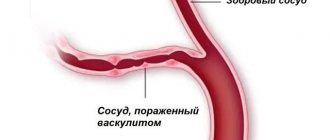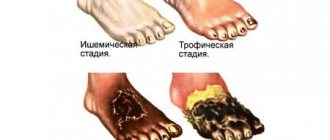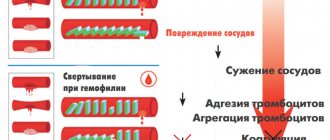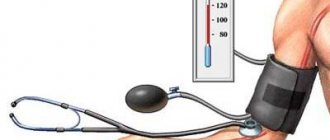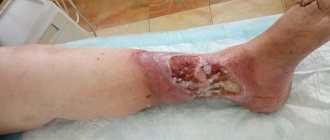Classification
The disease is divided into many subtypes, differing in reasons for development, localization, specificity and type of affected vessels. There are two main forms:
- Primary (or leukocytoclastic) vasculitis, which is an independent disease and is not accompanied by other pathologies;
- Secondary (or rheumatoid), developing against the background of other diseases - rheumatoid arthritis, dermatomyositis, lupus erythematosus.
Vasculitis of the lower extremities is also divided into diseases of large, medium and small vessels.
According to the severity of the pathology, there are:
- mild - the rash is not profuse, the general condition of the person is unchanged;
- Moderate - the rash is clearly defined, joint pain, the presence of red blood cells in the urine test, the patient feels weak, decreased appetite;
- severe - a rash almost all over the body, clear changes in the joints, developing kidney failure, often pulmonary and intestinal bleeding, the person’s condition is considered severe.
According to localization, vasculitis is divided into segmental (in individual places) and systemic, when there is no specific localization. The second option is the most difficult to treat, since vasculitis occurs in different parts of the body, which makes it difficult to carry out appropriate therapy.
Depending on the size of the damaged vessels and the depth of their location, superficial and deep vasculitis are distinguished.
In medical practice, the disease is also classified according to Ivanov’s method, recommended for use:
- Skin - changes in the vessels of the upper layer of the skin, divided depending on the clinical picture into several subtypes (hemorrhagic, urticaria, ulcerative-tumor, etc.);
- dermohypodermal - a disease of the vessels located between the upper and deep layers of the skin, manifested by a nodular form, often with ulceration;
- Hypodermal - damage to the blood vessels of the deep layers of the skin, often manifested by a nodular, ulcerative course.
Each type and subtype of the disease has its own clinical picture.
Symptoms of hemorrhagic vasculitis
There are several forms of hepatitis B:
- Skin or simple : characterized by the appearance of a specific itchy rash on the lower extremities and buttocks (small pinpoint hemorrhages that rise above the skin and do not disappear with pressure). Over time, the red rash darkens and disappears, leaving areas of increased pigmentation.
- Joint: patients complain of pain in the area of large joints (knees, elbows, hips), their swelling and dysfunction.
- Abdominal : nausea and vomiting, severe abdominal pain (often cramping), possible intestinal bleeding, development of intestinal gangrene (due to thrombosis).
- Renal : urine becomes pink or red due to the admixture of red blood cells, its quantity decreases, protein appears in tests, which are signs of the development of glomerulonephritis and the threat of developing chronic renal failure.
- Fulminant : characterized by the development of DIC syndrome and high blood loss.
Often the disease begins with an increase in body temperature to 38-390C, and patients also note general weakness and increased fatigue. Characteristic wave-like course of the disease.
Symptoms and manifestations
The initial stage of vasculitis has no obvious symptoms and it happens that the disease is not immediately recognized. Although symptoms vary, there are a few common symptoms:
- inflammatory changes in the skin;
- swelling, rash, hemorrhage, necrosis;
- The lesion appears symmetrically on both legs;
- The rashes look like red spots, nodules, erosions, ulcers;
- The initial manifestation is predominantly in the legs.
Vasculitis is characterized by the presence of purpura. This is a reddened area of skin raised above the surface of the skin that can be felt with your fingers.
In addition, the person experiences pain in the joints and muscles, general weakness, itching and burning of the affected areas of the skin, and has a fever of more than 38 degrees.
For vessels of different sizes, the symptoms of the disease are slightly different:
These symptoms only allow us to determine the general clinical picture. To make a definite diagnosis, it is necessary to identify symptoms characteristic of this subtype of vasculitis.
Why is it developing?
As experts note, today the mechanism of formation of such a violation is not completely clear. Autoimmune disorders are considered one of the main factors. There is also an opinion that vasculitis can manifest itself against the background of the following provoking factors:
- infections - both acute and chronic;
- oncological diseases;
- against the background of overheating or hypothermia;
- for thermal damage to the skin, including sunburn, which is familiar to many.
It also happens that vasculitis becomes a consequence of a reaction to medications, when an allergy to the medicine develops. Now they are talking about a list of about 150 drugs that can trigger a reaction.
Causes of the disease
To date, the reasons that provoke the development of this pathology have not been fully studied. The main provoking factor is a failure of the body's immune system. This may be an infectious disease, especially a viral one.
As inflammation progresses, it increasingly affects the blood vessels, impairing the blood supply to the organ, leading to hemorrhage, necrosis, as cells die in the absence of adequate nutrition.
The following factors can provoke changes in the blood vessels of the lower extremities:
- frequent colds without proper treatment;
- hereditary predisposition;
- thyroiditis;
- diseases that have become chronic;
- untreated or advanced arthritis;
- tendency to allergies.
Constant stress, hypothermia, injuries, and uncontrolled use of certain medications have a negative impact.
Sometimes bruises appear on the skin along with the rash.
Experts believe that they are caused by autoimmune disorders, and in other cases, vasculitis provokes hereditary diseases and ailments caused by failure of internal organs.
Bruises occur due to increased fragility of capillaries, which are easily damaged by light pressure on the skin. If they are symmetrical (in the ankle, knee area), then hemorrhagic vasculitis is diagnosed.
2. Why is vasculitis dangerous?
The danger of vasculitis lies in the possibility of developing serious complications. In particularly severe cases, when part of a blood vessel stretches and dilates, the likelihood of an aneurysm
– bulging section of the walls. The danger of this pathological process lies in the rupture of the aneurysm, which can cause many irreversible consequences: from circulatory disorders to death.
In the case of the opposite behavior of blood vessels during vasculitis, when inflammation contributes to their narrowing, there is a possibility of cessation of blood supply to individual organs and tissues. If alternative blood vessels cannot provide the required amount of blood to them, necrosis of the affected tissues or organs may occur.
Visit our Rheumatology page
Which doctor treats, how is the disease diagnosed?
Having discovered the first symptoms indicating this disease, a person is interested in what the doctor is treating for it.
If you have a rash on the skin of your legs and other symptoms of vasculitis, consult your doctor. To make the correct diagnosis, he will refer specialists for consultations - a dermatologist, rheumatologist, neurologist, allergist, hematologist and others.
The attending physician prescribes additional tests:
- Clinical and biochemical analysis of blood, urine;
- ECG, X-ray, ultrasound;
- biopsy;
- immunological analysis.
Most often, when the disease is first detected, the final diagnosis is made by a rheumatologist, who, if necessary, refers the patient to a specialist. Based on the results of the study, the specialist prescribes treatment aimed at eliminating the causes of vasculitis.
After completion of treatment, the patient must be under medical supervision for two years to avoid relapse.
Diagnosis of hemorrhagic vasculitis
At the Yauza Clinical Hospital, patients with suspected Henoch-Schönlein disease are prescribed the following set of examinations:
- general blood analysis;
- general urine analysis;
- coagulogram;
- determination of the level of antistreptolysin-O, IGA in peripheral blood;
- tissue biopsy of the affected organ or part of the body, followed by histological examination of the biopsy.
To make a diagnosis of hemorrhagic vasculitis, the patient must have two or more diagnostic criteria:
- specific rashes not associated with low platelet levels;
- manifestation of the disease before the age of 20 years;
- widespread abdominal pain that worsens after eating, intestinal bleeding;
- granulocytic infiltration of the walls of microvasculature vessels, which is confirmed histologically.
Treatment
To get rid of vascular inflammation, they require medications. In each case, therapy is selected individually after establishing the exact form of the disease.
Traditional methods
Classic treatment involves taking medications such as:
- Non-hormonal anti-inflammatory drugs (Naproxen, Indomethacin), which relieve inflammation and pain, but are contraindicated for stomach ulcers, kidney and liver diseases, and during pregnancy;
- glucocorticoid drugs, such as prednisolone, to suppress an immune system that has become aggressive towards its own body;
- Cytostatics (“Cyclophosphamide”), slowing down cell division;
- antihistamines (Suprastin) for the nodular erythematous form of the disease;
- Foods containing vitamin C and calcium to help keep blood vessels tight and prevent breakage.
In addition to tablets, external preparations are prescribed - topical ointments (Iruksol, Solcoseryl). Affected areas may be blurry and solid green. To reduce lumps, use dry heat; to reduce joint pain, use applications with Dimexide.
Physiotherapeutic procedures will be useful - ultraviolet blood irradiation, plasmapheresis, oxygen therapy.
Traditional therapy
Also, folk remedies have a positive effect in the treatment of vasculitis. To avoid negative consequences, consult your doctor before using them.
For use in therapy:
- Decoctions of tricolor violet, collection of nettle leaves, ergot, elderberry, yarrow, Japanese poplar berries;
- homemade ointments from a mixture of birch buds and intestinal fat, pine resin, which can be applied to sore spots;
- Elderberry infusion, lemon-alcohol tincture.
Treatment with plant decoctions containing vitamins is useful. Leaves of black currant, St. John's wort and centipedes are used.
To improve blood circulation in the legs, exercises such as “bicycle”, “scissors”, “birch”, and lifting weights on the tips of the fingers are recommended.
Therapeutic measures
At the Yauza Clinical Hospital, treatment of hemorrhagic vasculitis is aimed at achieving the following goals:
- elimination of clinical signs of pathology;
- reducing the risk of complications;
- preventing damage to vital organs;
- complete recovery of the patient or achievement of stable long-term remission.
To do this, our rheumatologist develops an individual treatment regimen for each patient, which includes:
- bed rest for at least 3 weeks;
- avoiding contact with allergens;
- diet therapy;
- prescribing enterosorbents, antihistamines, antispasmodics, hemostatic agents and antiplatelet agents;
- in some cases, the use of hormones and cytostatics is justified.
To reduce the destructive influence of circulating immune complexes and enhance the effectiveness of drug therapy, patients with hepatitis B undergo extracorporeal hemocorrection.
